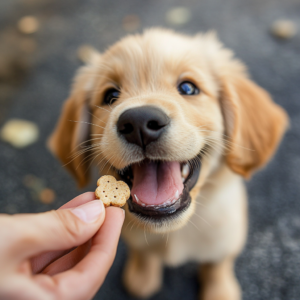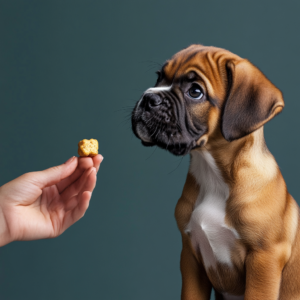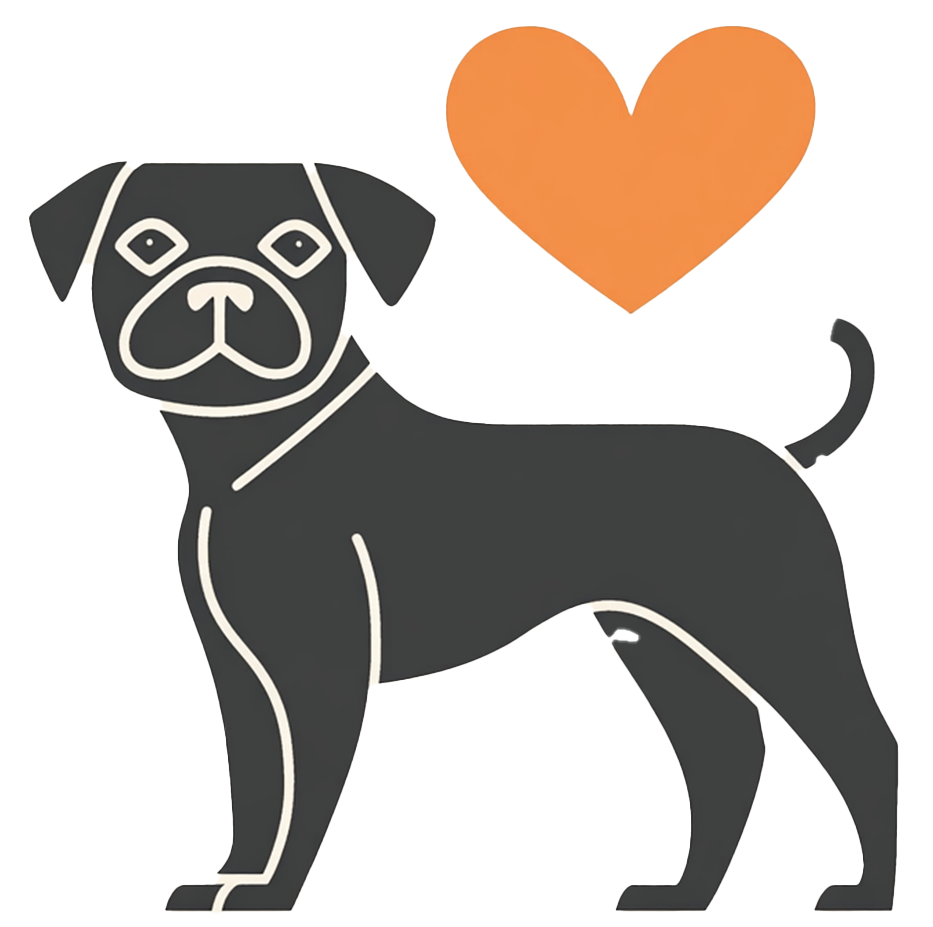Bringing a puppy into your life comes with endless joy and, of course, a few challenges! One of the most rewarding parts of puppy training is using treats to encourage positive behavior. But with so many options available, how do you know which treats are safe, nutritious, and ideal for your growing pup? In this post, we’ll dive into what to look for when choosing treats for puppies, ensuring that your furry friend gets the best without compromising their health.
1. Why Treats Are Important for Puppies
Training and Positive Reinforcement
 Treats are an essential part of training for puppies. Using positive reinforcement helps your puppy associate good behavior with a reward. Most puppies are highly food-motivated, making treats a fantastic way to keep their focus during training sessions. According to Smart Bark, high-value treats, which are especially delicious or enticing, can make a huge difference in training by maintaining your puppy’s attention and motivation. This is particularly important during the early stages of a puppy’s life, when you are trying to reinforce the basics.
Treats are an essential part of training for puppies. Using positive reinforcement helps your puppy associate good behavior with a reward. Most puppies are highly food-motivated, making treats a fantastic way to keep their focus during training sessions. According to Smart Bark, high-value treats, which are especially delicious or enticing, can make a huge difference in training by maintaining your puppy’s attention and motivation. This is particularly important during the early stages of a puppy’s life, when you are trying to reinforce the basics.
As I’ve seen with Lando, my energetic pup, the right treats can turn a chaotic training session into a productive and fun one. His love for a good treat meant that commands like “sit” and “stay” became second nature to him faster than I expected! Puppies often respond quickly to reward-based training, making treats an effective tool for teaching basic commands and improving overall behavior.
Encouraging Good Behavior
Besides training, treats can be used to reinforce positive behavior throughout the day. Whether it’s for following commands, learning house manners, or simply staying calm in new situations, a quick reward reinforces that they’re doing the right thing. However, it’s essential to ensure that treats are used strategically to avoid overfeeding and reliance on them for every good action.
According to expert advice from Purina, it’s important to balance treat rewards with regular meals and other forms of positive reinforcement, such as verbal praise. This helps prevent puppies from expecting a treat for every small action and avoids excessive calorie intake that could lead to weight issues later on.
2. What to Look for in Puppy Treats
Size and Texture
When selecting treats for puppies, size and texture are critical factors. Puppies need small, bite-sized treats that are easy to chew and swallow, especially during training. Soft treats tend to work best because they can be eaten quickly, allowing you to keep your puppy’s attention focused on learning. As recommended by experts here, training treats should be easy to digest and appropriately sized for your puppy’s small mouth.
For example, my older dog, Nico, struggled with harder treats as a young puppy. We switched to softer options, and he responded much better to his training routine. It’s essential to match the treat texture to your puppy’s needs—softer treats for younger pups and those with sensitive teeth, and perhaps harder chews for teething puppies who need something a little more durable.
Additionally, it’s worth noting that small treats keep your puppy from getting too full too quickly, ensuring they stay motivated for longer training sessions. As Raw & Fresh points out, small, soft-textured treats are ideal for effective training, especially when given frequently during short, intensive sessions.
Nutritional Value
Choosing treats that provide nutritional value is crucial. Puppies are in a critical stage of growth, and everything they consume should support their development. Look for treats that are rich in protein, low in calories, and free from harmful fillers like grains and artificial additives. Many health-conscious pet owners prefer grain-free and organic options to ensure their puppies are getting only the best ingredients. Grain-free treats, for example, can be a great alternative if your puppy has a sensitive stomach.
Smart Bark highlights that natural ingredients, such as real meat and vegetables, provide essential nutrients for growing puppies. Additionally, organic treats free from preservatives or artificial additives are popular choices for ensuring the long-term health of your puppy. Keep an eye on calorie content, as treats that are too rich can quickly add up and contribute to weight gain, especially for small or less active puppies.
Avoiding Harmful Ingredients
When selecting treats, it’s essential to avoid harmful ingredients such as artificial colors, sugar, and salt. Some human foods, including chocolate, grapes, and onions, can be toxic to puppies, so these should be avoided at all costs. Opt for natural, safe ingredients that complement your puppy’s overall diet and contribute to their well-being.
According to the advice on Purina’s website, treats should ideally complement a balanced diet rather than act as a replacement. Fruits like apple slices and vegetables like carrots can serve as healthy, low-calorie treats that provide both nutrition and a bit of variety. However, moderation is key, and you should always check if a particular fruit or vegetable is safe for your puppy before feeding it to them.
3. Types of Safe Puppy Treats
Commercial Treats
There are many high-quality commercial treats designed specifically for puppies. These treats are typically soft, small, and free from harmful additives. Brands like Smart Bark and Raw & Fresh offer great options that focus on natural ingredients and high nutritional value. Look for treats that use real meat, fruits, and vegetables to support your puppy’s growth without compromising their health.
With Lando and Nico, I’ve found that treats from reputable brands worked best. Smart Bark offers a fantastic range of puppy-friendly treats that are perfect for training sessions. They ensure treats are appropriately sized for small mouths and contain nutritious ingredients that help puppies thrive.
Healthy Homemade Treats

If you prefer to make your own puppy treats, there are plenty of safe and healthy options you can create at home. Ingredients like pumpkin, carrots, and apples make great bases for homemade treats. They provide essential nutrients while being gentle on your puppy’s stomach. Homemade treats give you complete control over the ingredients, so you can avoid anything that might be harmful or unhealthy for your puppy.
Here’s a simple homemade recipe you can try:
- 1/2 cup of canned pumpkin (unsweetened)
- 1 egg
- 1/4 cup of rolled oats
Mix these ingredients together, form small bite-sized balls, and bake at 180°C for 20 minutes. These treats are soft, easy to digest, and perfect for puppies! You can also modify the recipe by adding other safe ingredients, such as finely chopped carrots or blueberries, for added variety.
For more detailed recipes and ideas, check out T. Forrest’s guide on healthy treat options.
4. How to Use Treats Responsibly
Moderation Is Key
As much as puppies love treats, it’s important to give them in moderation. Overindulging your puppy with treats can lead to weight gain and poor eating habits. As a rule of thumb, treats should make up no more than 10% of your puppy’s daily calorie intake. This ensures that their main meals still provide the bulk of their nutrition.
With Lando, I learned early on that too many treats during training sessions meant less interest in his meals 🐾. I had to cut back on treat portions and mix in verbal praise to keep his diet balanced. According to Purina, sticking to low-calorie treats can also help maintain a healthy weight while still rewarding your puppy during training.
Frequency and Timing
It’s important to establish a regular schedule for when you give treats. Treats should ideally be used during training or to reward specific good behaviors, rather than given freely throughout the day. If you’re using treats as part of a training regimen, aim to use small, frequent rewards during the learning phase, then gradually reduce them over time.
From my own experience, I found that giving treats outside of training can sometimes confuse puppies. Nico once began expecting a treat every time he sat quietly without prompting! By reserving treats for training sessions, it helped him understand when a reward was truly earned.
5. Treat-Based Training Tips
Start Small and Build Up
When training a puppy, start with very small rewards and gradually reduce the frequency of treats as they improve. Treats should be tiny so you can offer them often without filling your puppy up too quickly. According to Raw & Fresh, bite-sized treats work best for training because they are easy to eat and don’t distract your puppy from the task at hand 🐶.
When I was training Lando, I started with frequent rewards for basic commands like “sit” and “stay.” Once he mastered those, I began giving him a treat only after he followed a series of commands in one go, which helped him progress faster.
Use High-Value Treats for Tough Challenges
Some training situations, like getting your puppy to walk calmly on a lead or focus in a distracting environment, may require high-value treats—these are treats your puppy finds particularly irresistible, like small pieces of cheese, chicken, or a favorite commercial brand. As Smart Bark suggests, using special treats in tough situations can motivate your puppy to stay focused during more difficult tasks.

Nico used to get so distracted during outdoor training that I had to switch to high-value treats like cheese to hold his attention 🧀. It worked wonders, and soon he was listening even when there were other dogs around!
Avoiding Over-Reliance on Treats
While treats are a great way to reinforce good behavior, it’s important not to let your puppy become reliant on them. Once your puppy has learned a command or behavior, start to phase out treats and use other forms of positive reinforcement like verbal praise, belly rubs, or playtime.
For example, Lando learned to sit and stay so well that he started following commands even without the promise of a treat. Now, he’s just as happy with a “good boy” and a belly rub! 😊.
6. Bonus Tips for Successful Treat-Based Training
Keep Training Sessions Short
Puppies have short attention spans, so keep training sessions brief but consistent. A few minutes, several times a day, will be far more effective than one long session. This ensures your puppy stays engaged without getting bored or frustrated. Aim for about 5-10 minute sessions when starting out.
For Lando, I found that training him for 10 minutes right before his meals worked best, as he was more motivated when he was a little hungry. Short, successful sessions kept him engaged and excited for more!
Use Treats Wisely

Over time, you should gradually reduce the number of treats you give, replacing them with praise or other rewards. This will help your puppy understand that good behavior is expected even without constant rewards. Start by giving a treat every time your puppy performs well, then slowly space out the rewards as they improve.
With Nico, we began rewarding him every other time he followed a command, and eventually, he started responding to just verbal praise. Transitioning to fewer treats made training easier and more sustainable in the long term.
7. Conclusion
Using treats responsibly is key to raising a well-trained, healthy puppy. While treats are an effective tool for training and reinforcing good behaviour, it’s important to use them wisely, ensuring they are nutritious, appropriate in size, and given in moderation. As you move forward with treat-based training, remember to mix in verbal praise and other rewards to avoid over-reliance on treats. Whether you’re working on basic commands or tackling tougher challenges, treats can help your puppy thrive and grow into a happy, well-behaved dog 🐾.
Do you have any favorite treat-based training tips? Drop a comment below and share your experiences with your puppy! 🐕





